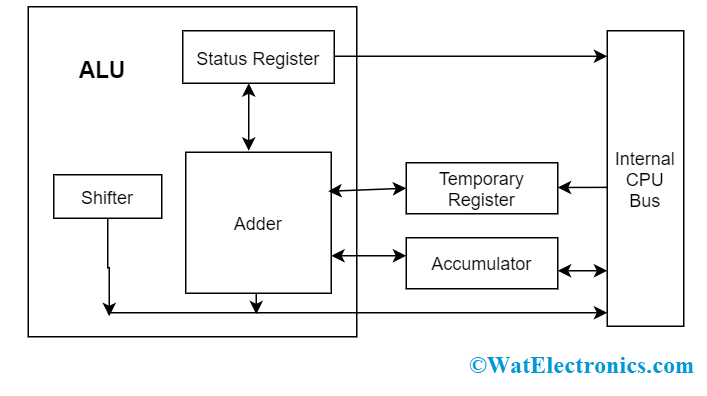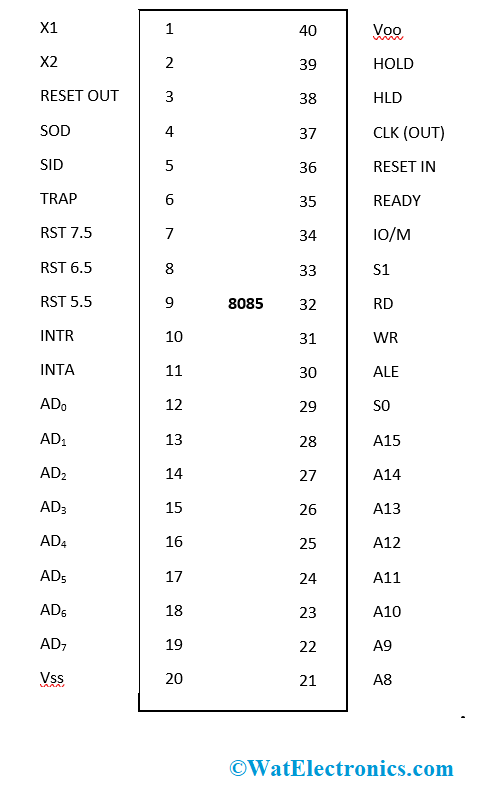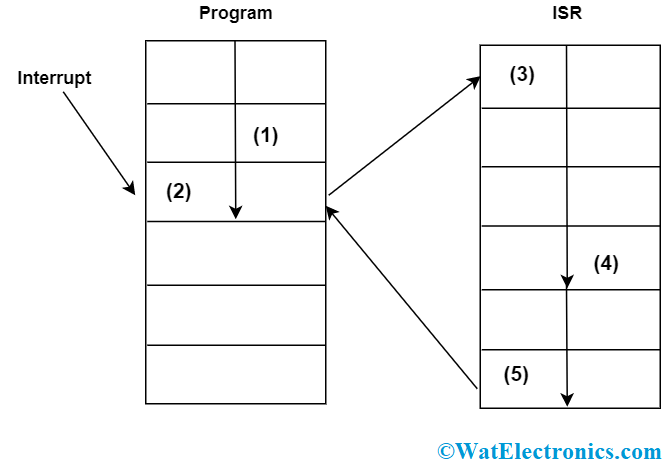As the invention of IC’s (Integrated Chip’s) gained the utmost importance, the microprocessor which is developed using IC’s is also more into implementation. Extending the functionalities of IC, microprocessors hold the capability of performing complicated functions on a single chip. Microprocessors brought up the vast revolution in the world of technology and they are in utilization to date. From the development of 1st generation to 5th generation, each phase holds its benefits and all the advantages allowed for the development of 8080 and 8085 series of microprocessors developed by Intel. The current-day computers dependent on microprocessors perform speedy calculations than computers and available at a small fraction of the price of such mainframe computers. Let’s be clear on the concepts of the 8085 microprocessor, its pin diagram, architecture and many more.
What is 8085 Microprocessor?
With the support of NMOS technology, 8085 microprocessor was developed by Intel in the year 1977. Adding more features to the 8080 microprocessors, 8085 was developed where it can address up to 64KB. It is the programmable electronics IC with an 8-bit data bus and 16-bit address bus. 8085 microprocessors fabricated on a single chip can perform computations and data transfers. The processor is developed with an 8-bit ALU, so it performs 8-bit operations. It requires a +5V power supply and operates at 3.2 MHz single-phase CLK.
8085 Microprocessor Architecture
8085 internal architecture comprises of various units such as timing and control unit, interrupt control serial input-output control, registers, and ALU. Here, CPU acts as the core of the microprocessor and it has instruction register and decoder, timing control, various registers, and serial I/O control. The below diagram is the internal architecture of 8085 microprocessor. This is the overview of the architecture

8085 architecture
ALU
It is considered as a multi-operational combinational circuit that performs both logical and arithmetic operations like logical AND, logical OR, addition and subtraction. The length of the internal data bus decides the word length of ALU, it is of 8-bits and is managed by timing and control bus. ALU consists of
- Adder: Performs all the arithmetic operations such as increment, addition, subtraction, and decrement. And all these operational results are stored in the accumulator.
- Shifter: Performs logical operations such as shift left, shift right, rotate left, rotate right and others.
- Status Register: It is even considered a flag register. Various flags are here, and they correspond to perform their specific operations.

8085 microprocessor ALU architecture
Timing and Control Unit
These signals are required for the execution of various instructions. Timing and control signals handle the data flow and memory management in between peripherals and CPU. This unit provides status, timing and control signals and these manage the functionality of I/O and the memory device
System Bus
The communication between memory and I/O devices is done through an Address bus, control, and data bus.
- Data bus: This is the bidirectional one. This is responsible to carry commands from microprocessor to memory. The data bus size specifies what kind of arithmetic operation to be performed.
- Address bus: It is a 16 wired bus. The size of the memory depends on the address bus size. The microprocessor sends instructions to memory through the address only. This is unidirectional and only way transfer of signals is possible (i.e. from the microprocessor to memory).
- Control Bus: To control and co-ordinate microprocessor operations, the control bus signals are necessary. Few of these signals are unidirectional and few are bidirectional. It is like read/write signals.
Registers
The registers of 8085 are six general-purpose registers and are 8-bit each and they are of B, C, D, E, H, and L. To perform 16-bit operations, these registers are paired as BC, DE, and HL.
Please refer to this link to know more about 80286 Microprocessor MCQs, 8085 Microprocessor MCQs
- Accumulator: This is the part of ALU, and it is of 8-bit. It performs arithmetic and logical operations and used to store 8-bit data. The results of the operation are stored in the accumulator.
- Flag Register: It contains 5-flag registers and they are Carry Flag (CF), Parity Flag (PF), Zero Flag (ZF), Sign Flag (SF) and Auxiliary Carry Flag (AC). These flag registers are used to analyze the test conditions. The SET or RESET status of the register are analyzed through the software instructions. When the accumulator and flag register are combined, it represents a PSW (Program Status Word). PSW is of16-bits and performs stack operations.
- Stack Pointer: It is a 16-bit register that points to the memory location and termed as the stack. It is treated as a memory pointer.
- Program Counter (PC): It is of 16-bit and manages to order the execution of commands. The main functionality of PC is to point to the memory location where the next byte address is to be retrieved.
- Instruction Register/Decoder: The current commands of the program are temporarily stored. The process here is that IR sends instruction from memory for the execution and the decoded data is then passed to the next level.
- Memory Address Register: It holds the address of the instruction of the next program which is received from the program counter.

flag registers
Microprocessor Pin Diagram
The pin diagram and description of 8085 are described as below:

pin diagram
Address/Data bus: The address/data bus pins are from A0 – A15. These signals are unidirectional where it sends signals only from the microprocessor to the peripheral devices.
Status and Control signals: Based on the pin combination of IO/M and S0, S1, the data bus status is decided.
ALE – It is Address Latch Enable signal. The data bus moves into an active state when ALE = 1. The lower 8-bits are enabled during the initial T state of the machine cycle.
S0, S1 – These are called status signals where the 4 combinations of these pins determine the operations of writing, reading, halt and fetching.
- IO/M S0 S1 Status of Data Bus
- L H H Opcode fetch
- L H L Memory read
- L L H Memory write
- H H L I/O read
- H L H I/O write
- H H H Interrupt acknowledge
- L L L Halt
Clock Frequency and Power Supply: The pins are described as
- Vcc – Need a +5V powers supply
- Vss – Pin for ground reference
- CLK (OUT) – It is used as a clock signal to refer to other devices
- X1, X2 – The frequency is divided between these two pins. To execute the system at 3MHZ, it should have a total frequency of 6MHZ.
RESET Signals
- RESET IN – When RESET IN = 0, PC = 0 and microprocessor moves into reset state.
- RESET OUT – It is used to reset the condition of MPU and even used to reset other devices.
Serial I/O Ports
8085 performs serial transmission through SOD and SID signals. SID is the input data line while SOD is the output data line.
Interrupts and Peripheral Signals
To interrupt a program in 8085, it uses five signals and those are:
INTR which is an interrupt request signal. INTA is the interrupt acknowledgment transmitted by the microprocessor after receiving the signal from INTR.
- RST 7.5
- RST 6.5
- RST 5.5
- TRAP
DMA Signals
HOLD and HLDA are the DMA signals.
Working
The microprocessor works on four operations through the system bus (address, data, and control bus).
- Memory Read – This is the operation used to read instructions from the memory.
- Memory Write – This is the operation used to write instructions to the memory.
- I/O Read – It accepts instructions from the input device
- I/O Write – It sends instructions to the output device
Features
It is an 8-bit microprocessor having a 40 pin DIL package. Address and Data buses are combined in this processor and this combination helps in providing additional control signals. It also has 1 non-maskable interrupt and 3 maskable interrupts. SID and SOD signals perform serial interfacing too.
8085 Addressing Modes
The specification of operands is based on 8085 addressing modes. They are
- Direct Addressing Mode
- Register Addressing Mode
- Immediate Addressing Mode
- Indirect Addressing Mode
- Implicit Addressing Mode
Interrupts in Microprocessor 8085
These are the signals created the external devices and these signals allow the microprocessor to execute an operation. There are 5 interrupt signals in 8085 and these are hardware interrupts. A small program or a routine is performed then facilitates the specific interrupting source and is termed as ISR.
TRAP – It comes under non-maskable interrupt and it holds maximum priority of all other interrupts. In general, it is in enable state and moves into a disabled state when acknowledged. When there is a failure, it performs ISR and transmits the information to the backup memory. IST transmits the control to the 0024H location.
RST 7.5 – It comes under maskable interrupt that has 2nd highest priority. When it is executed, the processor stores the data of the PC into the stack and addresses to 003CH location.
RST 6.5 – It comes under maskable interrupt that has 3rd highest priority. When it is executed, the processor stores the data of the PC into the stack and addresses to 0034H location.
RST 5.5 – It comes under maskable interrupt. When it is executed, the processor stores the data of the PC into the stack and addresses to 002CH location.
INTR – It comes under maskable interrupt and has the least priority. It moves into disable state when the microprocessor is in RESET state
When INTR = 1, the following conditions might happen −
- The microprocessor verifies the condition of the INTR signal at the time of instruction execution.
- When the INTR signal is ‘1’, the microprocessor completes the present instruction and transmits the low interrupt acknowledge signal.

8085 interrupt
Applications of 8085 Microprocessor
8085 microprocessor has various applications in many domains and few of those are listed as:
- In Instrumentation Domain – Used as digital kiosks, security systems, function generators, credit card administering, electronic cardiogram and implemented as control panel in the printing press machines.
- Entertainment – Implemented in multiple gaming consoles, DVD players and many others.
- Communication – Digital telephone sets, satellite communication, telephone exchanges and on television and computer motherboards.
- Home Appliances–Controllers based on microprocessors was widely used in home equipment such as in ovens, washing machines, refrigerators, and in many. These are also utilized to control multiple parameters such as temperature, force, and speed.
- Implemented in accounting systems
- Military applications
- Traffic light control
- Data acquisition systems
The technological advancements and innovations are progressing day-by-day and in the scope of this progression, microprocessors are the most important ones. But due to the technological advancement microprocessors are now replaced by microcontroller for small applications. To know more about microcontrollers click on this link. But how is a microcontoller different from a microprocessor to read on it click on the Difference between microcontroller and microprocessor.
Please refer to this link to know more about Microprocessor MCQs
FAQs
1. What is the use of microprocessor 8085?
A microprocessor is a single chip equipped with multiple components like resistors, transistors, diodes, and LEDs. The microprocessor is used to perform various arithmetic and logical operations.
2. Why it is called the 8085 microprocessor?
As the designation of the microprocessor itself specifies historical facts. With the amalgamation of technology enhancements, 8085 was invented in the late ’70s (close to ’80s) representing the initial two bits. 2) And it is the 8-bit, so-called the 3rd bit and it requires +5V and -5V operating voltages and this specifies the last bit. So, the processor is named as 8085.
3. What are the types of microprocessors?
There are mostly five kinds of microprocessors and they are of
- CISC
- RISC
- ASIC
- Superscalar and
- DSP
4. What is the memory size of 8085 microprocessor?
8085 can address up to 64KB of memory through a 16-bit address bus.
5. Is 8085 a RISC or CISC?
8085 is a CISC based processor and designed to perform some of the instructions at minimal time.
Thus, this is all about the 8085 microprocessor. The technological advancements and innovations are progressing day-by-day and in the scope of this progression, microprocessors are the most important one. As because of the wide and extensive range of applications in many domains, microprocessors are to be considered for the future progress of the technology. Know why microprocessors are mostly considered in many applications and where they are most implemented?
Please refer to this link to know more about automatic engine locking system for drunken drivers.